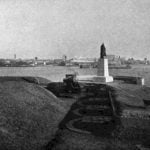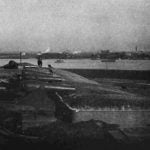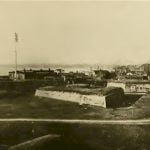
The spot whereon the flag staff stood which bore the stars and stripes that fervid morning upon which Francis Scott Key arose, saw that our flag was still there and jotted down the national anthem on the back of an envelope before going down to breakfast, still conspires with a large and lusty successor of this first staff to keep Old Glory flying in the heavens. The immediate surroundings, the harbor outlook, the busy city now sending its clamor over the point on which the old fort stands, all have changed in the years, but the part of the fort from which the banner of the new republic was sent forth so many years ago has undergone little transformation. A triangle of ground pointing toward open water, and a bare staff, these have little that Time can work wizardry with. The simple focus of Key’s inspiration has not been lost in the years, but the rest of the picture which roused his songster’s mood is only to be brought back by effort of imagination.
Fort McHenry is now a public park, the last federal trooper having been drawn out of the reservation in the fall of 1913. As such it has been beautified by the City of Baltimore, if the placing of benches in convenient spots, the sodding of terraces, and the cleaning of walks are to be considered in the nature of beautification; and it is occasionally used by Baltimoreans as a place of airing. Situated on a point of land separating the two parts of Baltimore’s heart shaped harbor, it gives charming views of the city. Gazing straight ahead from the walls of old Fort McHenry, one can see far down the river (very wide here) into the distance where the river joins the Chesapeake Bay. In the blue of the horizon can be faintly discerned the low squatty outline of the little hexagon of stone built by General Robert E. Lee before the Civil War and known as Fort Carroll.

Fort McHenry, Baltimore, Maryland
To the right hand, from this vantage point on the water side of Fort McHenry’s parapets, lies Spring Garden, the larger but the less busy part of Baltimore’s waterfront. To the left is the entrance to ” the harbor,” as it is affectionately called by Baltimoreans, with entire disregard for that magnificent half moon of water of more recent development, which we have already descried to the right.
The various points of historic interest in the fort and its grounds are marked with tablets and appropriate memorials, this work having been done in recent years by the city, by the Maryland chapter of the Daughters of the American Revolution and by various public spirited bodies of the municipality.
As one enters the grounds of the old fort, he is confronted first by a long, low, wooden structure with an archway through which can be gained a glimpse of a broad grass space. This is the parade. On the right of the parade is a row of cottages facing a narrow street, and at the end of this modest thoroughfare can be seen the eastern abutments of the old fort. As one approaches the fort itself the star shape of the walls is plainly observable and its dimensions easily taken in. It is not a large place, this historic old work, and makes no great impression upon the beholder from its material aspect. Batteries of ancient guns are mounted on the walls fronting the river. These were saved from destruction some years ago by the energetic work of some of the historical societies of the city. The reservation is entirely surrounded by a stone seawall which makes a very acceptable promenade, and here on summer days may be found couples viewing the beautiful marine prospects, and small boys indefatigably crabbing or fishing, but these energies have a purely legendary interest, for the crabbing and fishing for which the place was once famous are not now what they ought to be.

Fort McHenry, Baltimore, Maryland
Seen from the river as one enters Baltimore by steamer the old fort is at its best, for then one sees the long grassy inclines and the level of the parade ground and the soft foliage of trees contrasted sharply with the smoky city in the background. The fort proper is barely visible from the river, its walls not rising above the crests of the high embankments thrown up in front of it.
The point of land on which Fort McHenry is situated – Whetstone Point, as it was known in old times – was patented in 1662 by Mr. Charles Gorsuch of the Society of Friends, and the stretch that he acquired amounted to about fifty acres. It is thus that it comes upon the pages of history in the possession of one sworn not to use methods of violence. Time passed on, Mr. Gorsuch’s tract was divided, and at last came the brewing of the Revolution. It was this, which brought Fort McHenry into existence.
A battery was thrown up on the point, and in 1776 a boom was stretched across the river to the Lazaretto, a little projection of land on the northern side of the stream. Two hundred and fifty Negroes were employed in this work and their labors extended over a period of almost two years.
Yet this original of Fort McHenry did not see active service during the Revolution. Its greatest days were to be reserved for that short conflict which finally decided the Mother Country in the opinion that the American Colonies were of a right and ought to be free and independent. That so decisive a battle as the repulse of the British fleet before McHenry should have been staged at Baltimore is peculiarly appropriate when we remember the prominence of that type of sailing vessel known as the Baltimore “clipper” in the commerce of the country before the war and the great service these same slim, speedy vessels did as privateers during that conflict. The Baltimore clippers, it is not amiss to note, were built at Fell’s Point, about a mile and a half across the river from Fort McHenry, where modern Broadway, a thoroughfare, now has its terminus.

It was before the outbreak of the War of 1812 that the foundations of present day Fort McHenry were laid. In the closing ten years of the eighteenth century there was much ill feeling against England and war was declared in rumor many times before the actual outbreak of hostilities took place. At one of these periods of apprehension the citizens of Baltimore, at their own expense, started the erection of a star shaped fort under the direction of John J. Rivardi, engineer. In 1794 this erection, not complete but well started toward completion, passed to the Federal government and was named Fort McHenry in honor of James McHenry, secretary to Washington during the Revolution and Secretary of War from 1796 to 1800. The works were completed in 1805 and the formal cession to the Federal government took place in 1816.
It is hard to overestimate in the history of the country the importance of the defense of Fort McHenry and of the engagement at North Point, a corollary of this defense, though Marylanders themselves have been comparatively indifferent to it until lately. With that pride of race which is a heritage of the South and the feeling which that pride engenders that their men will do well as a matter of course, Marylanders have given this engagement rather casual attention until very recent years. Indeed, up to the last decade, it was not unusual to hear Baltimoreans refer to the heroic defenders of North Point, who checked a force many times more powerful than their own and inflicted terrible injury in mortally wounding the assailants’ commanding officer, as the ” North Point racers,” in humorous appreciation of the nimbleness of foot and ingenuity in evading observation which the men showed when finally they did break ground and retreated to Baltimore. Yet the times were critical enough. Heaven knows, and the part that these same racers and Fort McHenry played a worthy one in the final summing up. The British, it will be remembered, had proceeded by easy stages up the Chesapeake Bay, burning and pillaging wherever they chose and meeting little opposition. A detachment had crossed to the northwest through Bladensburg and had seized and given to the flames Washington, the capital of the nation, itself; and now the united force was turning its attention to a leisurely march north through Baltimore to the northern cities, where they hoped to complete their subjugation of the country. Their complete reverse at McHenry set back all of their plans, giving the northern cities time to arm and prepare, and demoralized them to a great degree, their demoralization being accompanied by a corresponding enheartening of all American sympathizers. The importance of the action is thus readily seen.

The historic attack upon Fort McHenry began on the morning of September 13, 1814, and continued until 7 o’clock of the next morning. During the engagement more than 1800 shells were fired by the attacking force. The total American loss was four killed and twenty-four wounded. In the land engagement of North Point, which preceded the attack by water on the city the American loss, was 150 killed and wounded and the British loss about 600.
While Fort McHenry was the main defense of Baltimore, the city showed arms in other directions as well. On the northern side of the harbor (across the river from Fort McHenry) were two long lines of fortifications which extended from Harris Creek, northward across Hampstead’s Hill, now Patterson Park, – about a mile in length, along which at short distances were thrown up semicircular batteries. Behind these on more elevated sites were additional batteries, one of which, known as Rodger’s Bastion, overlooked Fort McHenry. There were, also, connecting lines of breastworks and rifle pits running parallel with the northern boundary of the city, connected in turn by inner bastions and batteries, the precise location of which is not known. A four-gun battery was constructed at Lazaretto Point,
and between this point and Fort McHenry across the mouth of the harbor a number of vessels were sunk. Southwest of the fort, guarding the middle branch of the Patapsco (known as Spring Garden) against the landing of troops to assail Fort McHenry in the rear, were two redoubts, 500 yards apart, called Fort Covington and the City Battery. In the rear of these upon the high ground of the present Battery Square was a circular battery. A long line of platforms for guns was erected in front of Fort McHenry and was known as the Water Battery.

During the night, which followed the unsuccessful afternoon engagement of the 13th, a landing party was sent in boats with muffled oars to slip past the City Battery and Fort Covington and to take these works and McHenry in the rear. That this effort was not more successful is due to the presence of a large haystack near one of the American sentries. This sentry, becoming suspicious, touched a match to the haystack, and the sudden flames showed the landing party of British. In the engagement that followed the British were repulsed.
It was at dawn of the 14th that Francis Scott Key, who was a prisoner on the British flagship, received the inspiration to write “The Star Spangled Banner.” He saw that, despite the furies of the night, the American flag still waved over the little fort. The words, which he jotted down in the joy of that moment, were the subject of some reworking on his part, but, it is understood, had not been materially changed when he showed them to his brother-in-law. Judge Nicholson, after his exchange the next morning. The words were found to fit perfectly to the popular tune “Anacreon in Heaven.” Carrying the stanzas to the printing office of Benjamin Edes, copies of it were ordered printed. This was the birth of “The Star Spangled Banner.”
The real hero of the attack upon Fort McHenry is not, perhaps, given the acclaim that should be his. It was sturdy Colonel Armistead, commander of the fort. His intrepid spirit and fine ingenuity undoubtedly saved the day.

Among the tributes, which were rendered to Colonel Armistead after the engagement, may be repeated that of his old friend, the veteran Colonel John Eager Howard, who sent him a brace of ducks and some wine with the words:
The British are off and the Devil with them. You deserve the thanks of a grateful country. I am sending a brace of ducks and a bottle of Burgundy. I hope you may enjoy them.
During the Civil War Baltimore was again fortified. On the night of May 13, 1861, Major General Butler occupied Federal Hill, a commanding eminence overlooking the city and harbor. In the following month a strong fort was erected here by General Brewerton, which included the entire crown of the hill and mounted fifty guns. The building of Federal Hill Fort was an answer to the action of a mob in Baltimore in April 1861, which planned to seize Fort McHenry. This effort was frustrated by the garrison of 100 men under Captain Robinson which put up such a warlike front with such a display of grape and canister, that the enterprise was abandoned.
In September 1914, during the Star Spangled Banner Centennial, the fort and grounds were loaned to the City of Baltimore by the War Department for use as a public park. It is not to be expected that the old fort will ever again be called into active service.
